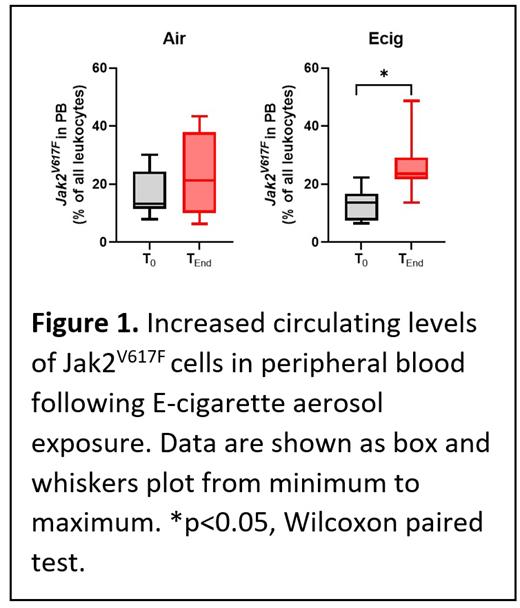Clonal hematopoiesis of intermediate potential (CHIP) increases the risk for hematological malignancies and cardiovascular disease with Jak2 being a commonly mutated gene in CHIP. Age is the strongest determinant of CHIP but environmental factors also play a role since only a fraction of the individuals with CHIP eventually present with overt clonal hematopoiesis. The popularity of electronic (E-) cigarette (E-cig) usage has increased but their health effects are not well-established. E-cigarettes have been associated with inflammation and oxidative stress and these can provide a selective pressure for the outgrowth of CHIP mutant cells. Here, we determined the impact of E-cig aerosol inhalation on the survival and/or expansion of Jak2 mutant hematopoietic cells by exposing bone marrow transplanted mice to E-cig aerosols.
Competitive bone marrow transplant assays were established to determine expansion of Jak2V617F mutant cells to E-cigarette aerosols. Lethally irradiated recipient mice in the CD45.1/2 background were transplanted with equal numbers of whole bone marrow cells from wild type (WT) (CD45.1) and Jak2V617F(CD45.2) mice (WT:Jak2V617F), or WT (CD45.1) and WT (CD45.2) (WT:WT) as transplant controls. Eight weeks post-transplant, mice were exposed to E-cigarette aerosols using a nose-only inhalation exposure system for 2 hours/day, 4 days/week for 3 months. Control mice were exposed to room air using the nose-only inhalation approach. At regular intervals, peripheral blood was drawn to determine the percentage of WT and Jak2V617F cells by flow cytometry. At euthanasia, the percentage of WT and mutant cells in the bone marrow (BM) and spleen was determined.
In competitive bone marrow transplants in a 1:1 ratio, this mouse model of Jak2V617F does not gain a selective advantage in relation to WT cells. Instead, we observe declining levels of Jak2V617F cells in the peripheral blood over time. The time point at which the Jak2V617F cells were at their minimum was recorded as time point 0 (T0). Mice were exposed for 12 weeks and then allowed to rest, to determine how E-cig exposure promotes Jak2V617F expansion, until termination of the experiment (Tend).
Mice exposed to E-cig aerosols demonstrated significant expansion of Jak2V617F cells at the end of the experiment compared to air exposed controls (Wilcoxon paired test, p<0.05). Jak2V617F Lin-, c-Kit+, Sca-1+ (LKS) cells in the bone marrow were also slightly increased in the E-cig group compared to the air group. To assess how inflammation is altered in the setting of prior E-cig aerosol inhalation, bone marrow derived macrophages (BMDMs) from exposed mice were stimulated with lipopolysaccharide (LPS) and secretion of the pro-inflammatory cytokines, TNFα and IL-6, were quantified by ELISA. WT:WT BMDMs from the E-cig cohort produced more TNFα and IL-6 than the WT:WT BMDMs from the air cohort. However, interestingly E-cig exposed WT:Jak2V617F BMDMs produced significantly less TNFα and IL-6 than the E-cig exposed WT:WT BMDMs.
This indicates that prior E-cig aerosol inhalation can sensitize WT cells to inflammatory stimuli while Jak2V617F mutant cells are more resistant to LPS mediated inflammation post E-cig exposure. This is particularly relevant in inflammation-induced hematopoietic stem cell exhaustion since a diminishing pool of WT HSCs provides selection pressure for the outgrowth of mutant HSCs.
Environmental factors such as combustible cigarette smoke and E-cigarette products can play a role in the clinical consequences of CHIP. We observed that in vivo exposure to E-cigarette aerosols supports the survival and expansion of Jak2V617F cells in bone marrow transplanted mice. Our data also indicates that E-cig exposure sensitizes WT cells to inflammation more than Jak2V617F mutant cells. Future work is aimed at determining E-cig exposure mediated inflammatory and apoptotic effects on WT and mutant HSCs and subsets of mature hematopoietic cells.
Disclosures
Fleischman:Pharmaessentia, CTI: Speakers Bureau; GSK, Incyte, CTI: Consultancy.


